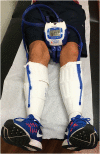Incidence of deep venous thrombosis following periacetabular and derotational femoral osteotomy: a case for mechanical prophylaxis
- PMID: 29876127
- PMCID: PMC5961113
- DOI: 10.1093/jhps/hny008
Incidence of deep venous thrombosis following periacetabular and derotational femoral osteotomy: a case for mechanical prophylaxis
Abstract
There are currently no established guidelines for appropriate antithrombotic prophylaxis following periacetabular osteotomy (PAO) or derotational femoral osteotomy (DFO). The purpose of this study was to determine the incidence of clinical deep venous thrombosis (DVT) following PAO and/or DFO wherein a portable, mechanical device and low-dose aspirin were used postoperatively for DVT prophylaxis. Patients who had undergone staged hip arthroscopy and primary PAO and/or DFO were prospectively reviewed. Following PAO/DFO, patients were prophylactically treated for thromboembolic disease with a portable, mechanical compression device for 3 weeks and low-dose aspirin for 4 weeks. Patients were followed in clinic until 24 months postoperatively. During the study period, 145 hips (124 patients) underwent surgery (PAO: 109, DFO: 24, PAO + DFO: 12). Overall, the incidence of clinically apparent DVT was 0% in the study cohort. Average estimated blood loss during surgery was 601 mL and five cases required blood transfusions of 1 or 2 units. Ten patients were seen in the emergency room 10-20 days after surgery presenting with calf tenderness and DVT was ruled out in all cases with ultrasound. There were no postoperative bleeding or wound complications. A portable, mechanical compression device and low-dose aspirin effectively lessens the risk of DVT following staged hip arthroscopy and PAO/DFO without an increased risk of bleeding complications.
Figures
References
-
- Crockarell JJ, Trousdale RT, Cabanela ME. et al. Early experience and results with the periacetabular osteotomy. The Mayo Clinic experience. Clin Orthop Relat Res 1999; (363:): 45–53. - PubMed
-
- Matta JM, Stover MD, Siebenrock K.. Periacetabular osteotomy through the Smith-Petersen approach. Clin Orthop Relat Res 1999. Jun; (363): 21–32. - PubMed
-
- Sugano N, Miki H, Nakamura N. et al. Clinical efficacy of mechanical thromboprophylaxis without anticoagulant drugs for elective hip surgery in an Asian population. J Arthroplasty 2009; 24: 1254–7. - PubMed
LinkOut - more resources
Full Text Sources
Other Literature Sources


